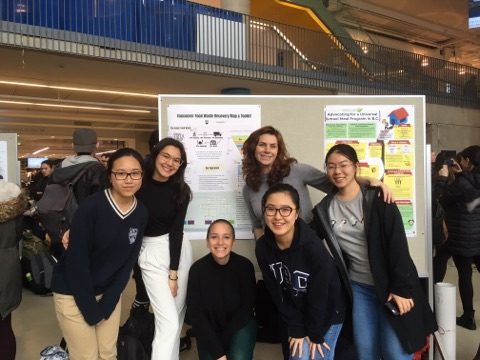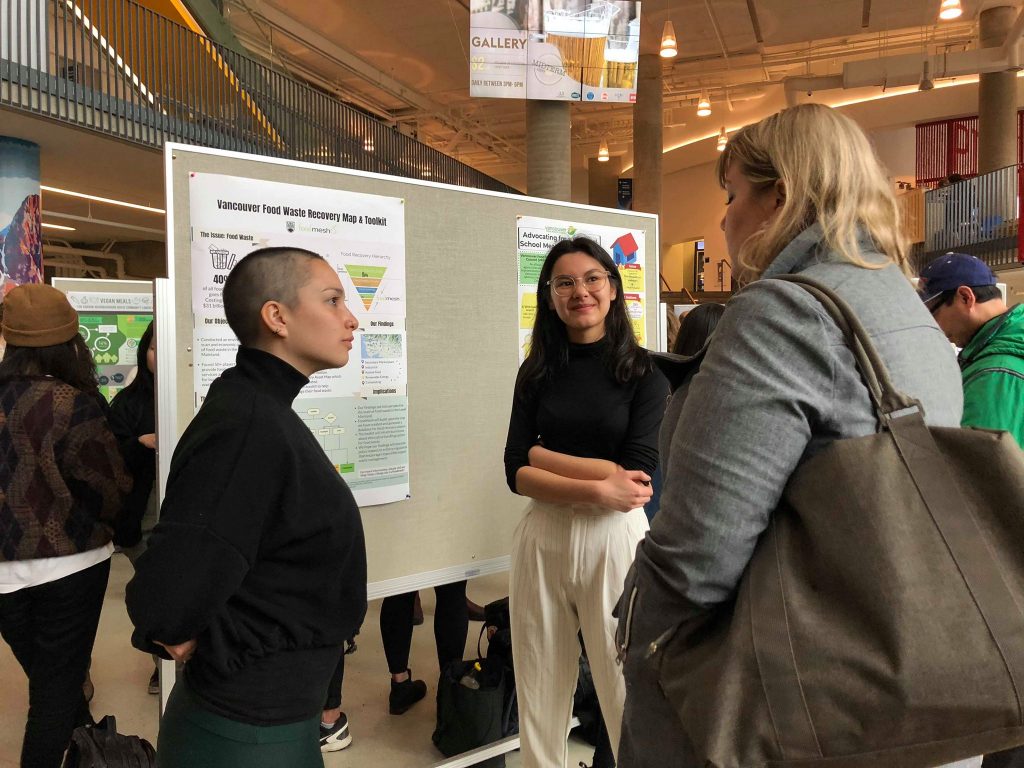April is just around the corner, the term has come to an end and so has our project. Working with Food Mesh on our CBEL project has been a rewarding experience!
Looking back on the last three months, our group gained a lot of knowledge on food waste recovery pathways. In this post, we will present to you the resource toolkit that we created. Moreover, we will discuss our moment of significance that has occurred within the last few weeks.

Upcoming Objectives and Strategies
| Week | Objectives | Strategies |
| 12 |
|
|
| 13 |
|
|
Moment of Significance
WHAT?
Following the objectives we put in place, we aimed to find 75-100 businesses that provide various food recovery services. We used keywords provided by our community partner, such as “waste to resource” and “repurpose” to locate businesses through online searches. Once we reached 50 businesses, we struggled to find more. Some of the businesses did not provide much information (e.g. services, operational details, contact information, etc.) online and thus we could not include them in our asset map and toolkit. We reflected on this issue and realized that businesses that use food waste may not want to market this to the public. Reusing food waste is still seen in a negative light amongst many consumers and businesses may not want to risk losing their customers.
Each business that we located in our map focuses on different areas of food recovery and operates on different scales. For example, some businesses accept packaged food products while others refuse certain types of packaging such as glass, because they lack the technology to unpackage the food. The businesses have different locations, provide various services, and also accept different types of surplus food. Therefore, when designing our toolkit, we struggled to design a simple flowchart as the pathways were unique and extremely complicated. We did not know how to integrate all the variables into the toolkit, while keeping it organized and easy to follow. We also faced the challenge of creating a comprehensive infographic and condensing our findings. We wanted to create a visual that would engage the public and provide them with enough information to give them a solid overview of our objectives with Food Mesh.

SO WHAT?
By facing the uncertainty and anxiety, we never stopped searching for resolution as a path to foster our learning during the project (Shulman, 2005, p. 18). We contacted our community partner every week and told her about our progress and the difficulties we encountered. We approached her about our challenge in finding more businesses related to food recovery to add to our asset map. We asked her whether we could include charitable organizations and food banks that accept edible food surplus. However, Jessica had already compiled a comprehensive list of businesses that focus on the edible part of food recovery. We were advised to try searching new keywords and to contact businesses through email and telephone. After doing all this research, we realized that there is an enormous gap in the food recovery database. In order to prevent food from going to waste and divert it from the landfill, it is important that these resources are in place and accessible. If not, businesses may not take the time to make educated decisions about dealing with their excess food.
By providing a resource toolkit, we hope that businesses would be able to better divert their waste. This was our third objective. We felt as if it was an important and complicated task. Before designing the final resource toolkit, Anita, Michelle, and Vicki brainstormed some ideas for the flowchart. All the members discussed together on how to categorize players based on scale, service types, and food exception. Our TA suggested that we use different colours to represent business types and correspond them to the food asset map we made earlier. Thus, we will be able to use the two tools together to easily identify a food waste management option and locate a suitable business.
The following toolkit is a simplified version of what our toolkit will look like. From left to right, it is arranged from the most favorable to the least favorable method of disposal. Starting from sorting the food waste into edible and inedible, we expanded into more detail for each category. The best choice for a company would be to sell their surplus food at a lower price to food services, secondary marketplaces, and value-added processors. If those options are not possible, they may choose to donate it. Inedible food is further divided into unspoiled and spoiled. If unspoiled, it can go to value-added processors or animal feed. If spoiled, the food will be mostly going to the creation of renewable energy or composting to salvage the remaining value.
One of the main challenges in designing the toolkit was keeping it simple, to not overwhelm the user. Just like the food system, food recovery can get very complicated. There can be many paths to recovery as there are many food waste types. We have decided to focus on clarity and provide our toolkit along with a PDF in which, certain terminology and suggestions can be found.

NOW WHAT?
Despite the fact that we all struggled to provide a lot of information and resources within our limited time frame, we were successful in providing quality work and in mapping out a fair amount of food-recovery companies, and in creating a simple toolkit for our poster presentation. We were all proud of the work that we accomplished and our community partner expressed her appreciation for our infographic. We will still work towards providing a more comprehensive toolkit that will be beneficial for recovery players in the Lower Mainland. We will also keep searching for more food recovery companies through networking and reaching out to local food businesses within the next week. Our time for this project is limited, but we strongly believe that visiting and contacting the businesses we mapped, we would gain a deeper understanding of operations. By practicing the Asset-Based Community Development method, we will be able to make more significant changes in social, political and economic challenges faced by those businesses (Mathie & Cunningham, 2003). Provided the toolkit and food recovery map, we hope the companies will be more open to considering sustainable alternatives to landfill disposal. Even though our group was not able to complete a policy investigation surrounding food waste, we would encourage future LFS350 students to carry on our project and engage in research about supportive government policies. They could potentially create a policy guide to complement our asset map and the resource toolkit.
We believe that a data analysis and database is created for businesses to divert their food from the landfill would be very beneficial. It is really important that we start educating companies about the impacts of food waste and the options for food recovery. As well, we think that it is very important that the Canadian government and policymakers emphasize the negative impacts on the environment caused by conventional waste disposal. We believe change will come from starting with small initiatives, providing resources and guides for businesses like we have in this project to facilitate diversion of food waste.
Reflection on This Journey
Vicki: I am appreciative and grateful to work on such an interesting and meaningful CBEL project with Food Mesh. Throughout this course, I realized that food justice is such a significant issue that requires more attention from the public. Our CBEL project is related to food waste recovery, which can potentially improve the efficiency of food distribution and in turn, release the stress of food insecurity. I think our work is very meaningful because it focuses on the food redistribution aspect that can essentially improve the efficiency of food supply chain. We hope our toolkit could be updated and consummated continuously, and be used by more and more businesses to reduce the food waste in Lower Mainland in the long run.
Anita: My knowledge of food waste and recovery has grown significantly throughout the course of our project. We were able to see the social, economic and environmental impacts of food waste and understand the significance of our project towards addressing food system issues. Researching so many businesses and different recovery methods was very interesting and it was valuable to see how food can serve as a sustainable resource. I would be very interested in expanding on this project by looking into different policy incentives for businesses. I think that creating more educational resources could also be valuable to increase awareness and address the issue collectively.
Michelle: The CBEL project was quite an experience for me. I am really interested in sustainable food systems and food waste, and working with Food Mesh brought so much learning to me. I went from being completely lost to excited about the project coming together to stressed and happy. I learned so much about Food Recovery, the issues and the missing data there exists. We, as a society, really need to start doing more preventing food waste and on recovery so we keep using food as a resource. I am really happy I got to work with Food Mesh on this project and do a significant research that hopefully will keep on being updated, improved and used in the future.
Milly: The CBEL project creates a great platform for us to seriously work on a real project. It is so grateful to see how the project with the Food Mesh developing into a mature and complete one. We have struggled with the big scope offered by our community member and the constraint time we had this term to complete everything on time. As keeping checking our processed with Jessica, we also have discussed adjustments in terms of objectives and the complexity of final toolkit. By working with the group and the Food Mesh, I personally have learned a lot in team working skills, confliction solving skills and communication skills. I also got great experience in using online tools and graphics to present our main objectives and findings concisely in a page of paper. By the time of writing the final report, I felt that we have fully managed the project.
Anne: I am so grateful that I get to work with Food Mesh this year. Starting with knowing nothing about food recovery, our CBEL partner had always been explaining everything patiently to us. There was a time we all got very lost in the wide objectives we have for the project but after talking with our Community Partner and Teaching Assistant, we narrowed them down and found a good way to start researching. The part that I was in charge of was the environmental scan for the Lower Mainland. The more we dig into it, the more we were shocked about the severe problem of food wasting and the crucial point of the existing of Food Mesh. For the future, we will need more company who would like to join the food saving journey and would like to think some more ideas on how to reduce food wasting even in the household level.
Thank you so much for following our journey in this learning process! Please leave any comments if you have any questions, we would love to engage in the conversation around food waste and possible solutions.
References
Mathie, A., & Cunningham, G. (2003). From clients to citizens: Asset-based Community Development as a strategy for community-driven development. Development in Practice, 13(5), 474–486. Retrieved from https://www.tandfonline.com/doi/abs/10.1080/0961452032000125857
Shulman, L. S. (2005). Pedagogies of uncertainty. Liberal Education, 91(2), 18–25. Retrieved from http://files.eric.ed.gov/fulltext/EJ697350.pdf